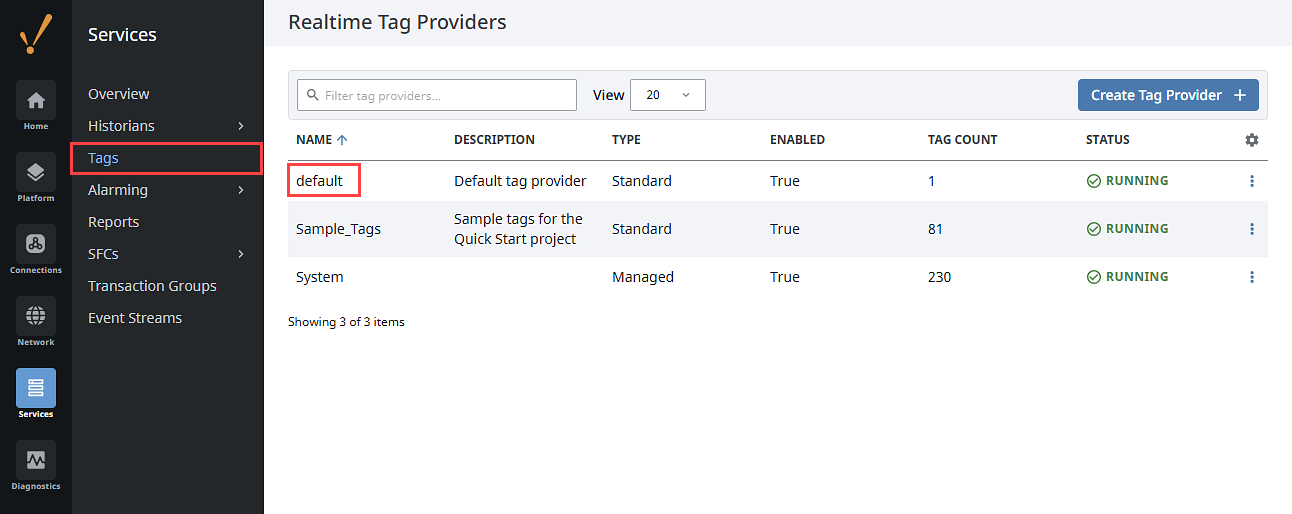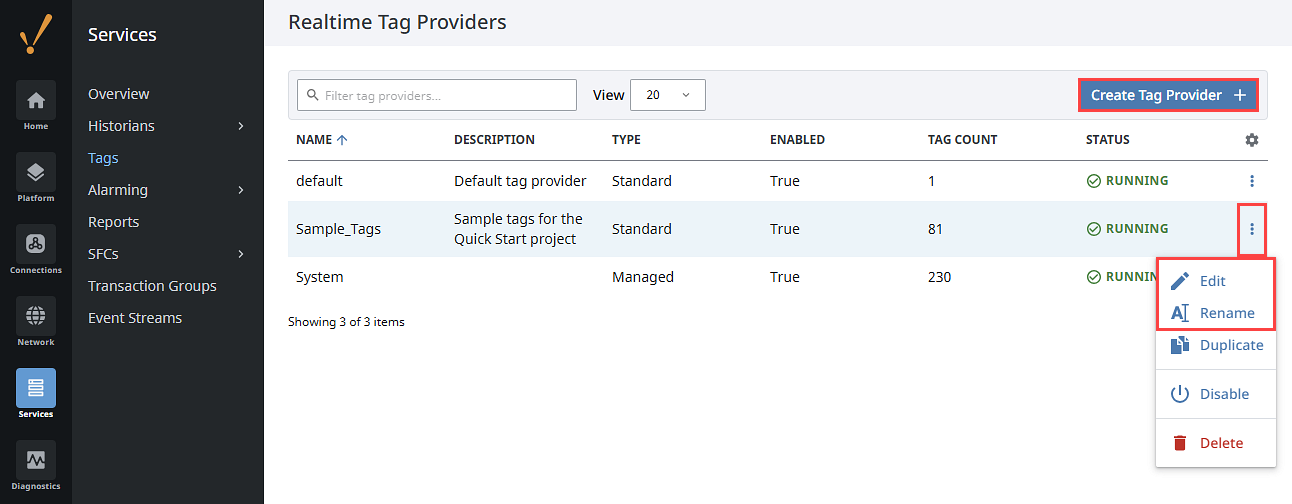Tag Providers
At the highest level of tag configuration is the Tag Provider. A provider is a tag database (a collection of tags) and a name. An Ignition Gateway can have any number of Tag Providers, and therefore the name is used to distinguish which provider a tag comes from. Tag Providers can be set up with security or even disabled independent of each other.
Every copy of Ignition has its own tags, spread across one or more Tag Providers. With the remote Tag Provider, Ignition can also see the tags on another Gateway, as long as the two Gateways are connected through a Gateway network.
All tags reside in a Tag Provider and have realtime values. Additionally, there is the concept of Tag Historian Providers, which can store and query historical data for tags. Each tag can optionally have a historian provider assigned to it to whom it will report value changes for historical storage.
Realtime Provider Types
There are two types of Realtime Tag Providers that you can choose from:
Standard Tag Provider
Standard Tag Providers store all configuration and do any execution (read, write, history, alarms) through the local Ignition Gateway. Every new Ignition installation automatically creates a Standard Tag Provider named default. You can add as many Standard Tag Providers as you want. This provider can be exposed or hidden from other Gateways on the network through the Gateway's OPC UA settings.
Remote Tag Provider
⚠️ 8.3 Known Issue
The Remote Tag Provider can become unresponsive if a user attempts to unshelve an alarm after the tag for that alarm is deleted. For a full list of known issues, click here to learn more.
Remote Tag Providers connect a remote installation of Ignition and access those tags. The remote Tag Provider works by creating a link from the local Gateway to a Tag Provider on a remote Gateway using a Gateway Network connection. The local Ignition may be allowed to read and write to the remote tags, but any execution is handled by the remote Gateway. So, things like writing to a PLC, alarms, and history will still be handled by the remote Ignition.
Put another way, "tags" in a remote Tag Provider are simply representations of the tags as they exist on the remote system. By default, a remote Tag Provider will fall under the Default Security Zone and be read only.
Every Gateway also includes a System Tag Provider, which is configured as a Managed type. The System Tag Provider stores Client and Gateway tags that provide status about the Ignition system. Additional Managed Tag Providers cannot be created by users, and the System Tag Provider cannot be deleted or modified. The only option available to edit is enabling or disabling the Tag Reference Tracker Store.
Configuring Realtime Providers
Realtime Tag Providers are configured in the Gateway's Services section under Tags. After installation, the Ignition Gateway will start with a standard provider defined.

You can edit a Tag Provider's name or settings by clicking on the three dots menu to the right and selecting Rename and Edit, or create new providers by selecting Create Tag Provider above the table.

When setting up a Realtime Tag Provider, naming your Provider the same name as the database connection is not recommended. Doing so may cause no values to be returned when querying tag data.
Standard Tag Provider Settings
Tags are stored inside of Ignition and executed by the system.
| Setting | Description |
|---|---|
| Name | The name of the provider. |
| Description | The description of the provider. |
| Enabled | If true, Tag Provider is enabled. Default is true. |
| Default Datasource | The default database connection to use for Expression tags that run SQL queries. All Query tags with default database providers selected with run their queries against this database source. |
| Value Persistence | The behavior for how Memory tag values will be stored. Possible values include:
|
| Tag Read Permissions | Any actor attempting to read any tag within this tag provider must have these permissions in addition to the target tag's permissions. Multiple security level paths can be specified by separating them with commas. If blank, tag reads for this provider will not be restricted by default. For example:Authenticated/Roles/Administrator, SecurityZones/MyZoneWhen multiple security levels are provided, the radio buttons determine if the user needs all of the listed security levels, or at least one. |
| Read Only | If enabled, writes to any tag within this Tag Provider will be rejected, regardless of the target tag's permissions. Disabled by default. |
| Tag Write Permissions | Any actor attempting to write to any tag within this Tag Provider must have these permissions in addition to the target tag's permissions. Multiple security level paths can be specified by separating them with commas. If blank, tag writes for this provider will not be restricted by default. See the example for the Tag Read Permissions setting above. |
| Tag Editing Permissions | Determines the roles required to edit, create, or delete tags in the provider. Expects a path to a Security Level. Multiple levels can be specified, separated by a comma. For example:Authenticated/Roles/Administrator, SecurityZones/MyZoneWhen multiple security levels are provided, the radio buttons determine if the user needs all of the listed security levels, or at least one. Edge Gateways can access the Tag Editing Permissions setting. |
| Allow Back-fill Data | If enabled, data will be allowed to arrive out of order from the source. Data from the past will be stored to history, but will not be used for alarms, scripts, or subscriptions. If false (default behavior), each value will be processed fully as it arrives. Default is false. |
| Enable Tag Reference Tracker Store | Enables the storing of Tag Reference entries to a database on the local Gateway for analysis in a Designer. Default is true. |
Remote Tag Provider Settings
Tag Provider from one Gateway is brought in to another Gateway.
| Setting | Description |
|---|---|
| Name | The name of the provider. |
| Description | The description of the provider |
| Enabled | If true, remote Tag Provider is enabled. Default is true. |
| Gateway | The name of the Gateway on the Gateway Network that this provider is coming from. |
| Provider | The name of the provider as it is on the remote Gateway. This does not have to be the same as its name on the new Gateway. |
| History Access Mode | This setting dictates how Tag history is queried for remote tags. Ultimately determines where records are processed. When set to GatewayNetwork, history requests will go through the Gateway Network. Meaning the remote gateway will query records from it's database, process the records, then send the results over to the requesting gateway.  When set to Database history requests will run against the database directly. In this scenario, the requesting gateway then processes the data.  |
| History Datasource | The datasource to query when History Access Mode is set to Database. |
| History Driver | If querying the database directly, this is the Gateway name of the remote system. It is used to identify data from that system in the database. |
| History Provider | If querying the database directly, this is the name of the Tag Provider on the remote system. It is used along with driver name to identify the correct tags in the database. |
| Alarms Enabled | If true, alarms configured on the remote Gateway will be enabled on the new Gateway. |
| Alarm Mode | How alarm state should be monitored. In 'queried', state will be queried through the Gateway network when necessary. In 'subscribed', the state will be subscribed, and updates will be sent asynchronously. Subscribed provides better performance, but uses more memory. |
| Allow Back-fill Data | If enabled, data will be allowed to arrive out of order from the source. Data from the past will be stored to history, but will not be used for alarms, scripts, or subscriptions. If false (default behavior), each value will be processed fully as it arrives. Default is false. |
| Enable Tag Reference Tracker Store | Enables the storing of Tag Reference entries to a database on the local Gateway for analysis in a Designer. Default is true. |
